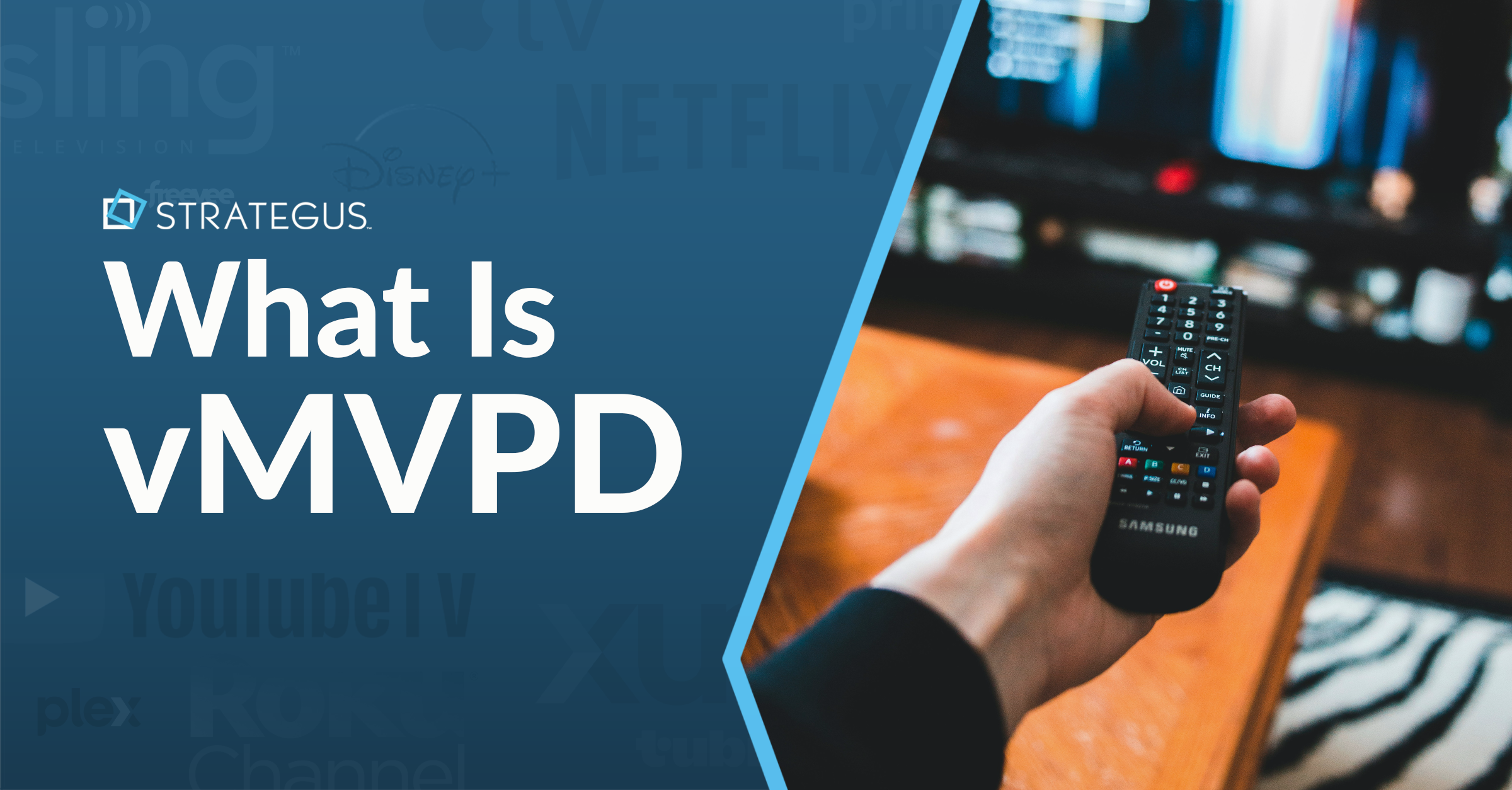- Home
- Strategus Blog
- What Is vMVPD? A Guide to Streaming TV Advertising in 2025
What Is vMVPD? A Guide to Streaming TV Advertising in 2025
 Traci Ruether
Traci Ruether
11 minutes read

Struggling to reach cord-cutters who no longer watch cable but still crave live TV? That’s where vMVPDs come in.
These platforms combine the scale of traditional TV with the precision of digital ads, minus the high upfront costs.
In this guide, we break down what vMVPD means and how to use it in your 2025 media strategy.
What Is a vMVPD?
A vMVPD, meaning virtual multichannel video programming distributor, is a paid streaming service that gives viewers access to their favorite TV channels without requiring a cable bundle. These services can be accessed on smart TVs, gaming consoles, and set-top boxes like Roku, as well as on mobile devices and computers.
Examples include YouTube TV, Sling TV, and Hulu + Live TV — all of which bundle popular TV channels and deliver linear content over the top (OTT).
vMVPDs drive revenue using a mix of subscription fees and ads. The ads are often served on a per-viewer basis, allowing marketers to pinpoint their audience based on demographics and preferences. As a result, households watching the same channel may experience different commercial breaks.
Because more households trade in their expensive cable bundles for streaming alternatives each year, vMVPDs have become one of the next frontiers of TV advertising. The rise of vMVPDs is reshaping the media landscape, requiring marketers to invest in this growing market to reach buyers.
Key Features of vMVPD
vMVPDs offer a host of features to incentivize subscribers. These include:
- Skinny bundles: By providing low-cost packages with fewer than 100 channels, vMVPDs offer more personalized and cost-effective options than traditional cable TV operators.
- Premium live content: Platforms like YouTube TV offer access to a wide range of premium live content, including channels like ESPN, MSNBC, CNN, TNT, Comedy Central, and ABC.
- On-demand content and unlimited DVR: While the foundation of vMVPDs is linear channels, many also offer on-demand content, as well as the ability to record and store shows for later viewing.
- Personalization: Personalization features, such as curated content recommendations and targeted commercials based on user preferences, contribute to a more tailored viewing experience.
For instance, a gluten-free viewer may see a commercial for a health food store, whereas an expecting mother watching the same channel would see a commercial for a local prenatal wellness clinic.
What Isn’t a vMVPD?
The media landscape has fragmented and grown to include many distinct business models. Countless acronyms now crowd the space — including MVPD, SVOD, and FAST.
Here’s how vMVPDs compare to these lookalike alternatives.
1. vMVPD vs. MVPD
MVPDs are the forefathers of television advertising. Cable television systems like Comcast Xfinity and satellite providers like Dish Network both fall in this category. With MVPDs, viewers need specialized equipment like a satellite dish or cable box.
MVPDs are also expensive and restrictive, often requiring annual contracts. Their market share continues to decrease each year, being subbed for both vMVPDs and other non-linear services like SVOD (which we’ll cover next).
The biggest difference between vMVPDs and MVPDs is how the content is distributed. With vMVPDs, internet streaming is the name of the game. MVPDs, on the other hand, rely on legacy broadcast technologies like coaxial cable.
Source: nScreenMedia, “Stress on MVPDs and vMVPDs ratcheting up for 2024”
This distinction gives viewers more flexibility. MVPD viewers are only able to access their favorite channels on their cable-connected TV. Meanwhile, vMVPD subscribers have the flexibility to log in anywhere with an internet connection.
Another major difference between the two is how the commercials are served. MVPD advertising is more costly and less targeted than ads that run on vMVPDs because the audience pool is broader. It’s also challenging to measure the results of traditional TV campaigns and optimize efforts based on data.
The number of MVPD subscribers dropped by 10% last year. This trajectory will only continue. And eventually, vMVPDs will be the only pay TV bundles available.
2. vMVPD vs. SVOD
Subscription video-on-demand (SVOD) services like Netflix are traditionally ad-free and the content is entirely on demand. This is changing, though.
For one, almost every major service now offers an ad-supported tier, making HVOD (or hybrid video on demand) a more accurate classification. Additionally, many SVOD giants are experimenting with live content (including live sports) to supplement their VOD library.
The biggest difference between vMVPDs and SVODs is how the content is consumed. With vMVPDs, viewers lean back for a scheduled broadcast and potentially surf between channels. Meanwhile, SVOD content is hand-selected based on the title rather than the channel airing it.
3. vMVPD vs. FAST
FASTs are free vMVPDs. Short for free ad-supported streaming TV, FAST services are growing at a breakneck pace. Popular FAST services include Pluto TV, Tubi, and the Roku Channel — with more popping up every day.
The promise of FAST is simple: viewers get free video content with regular commercial breaks. There’s no way around the ads, and the ability to fast-forward or rewind is limited. But the content is free, and most apps don’t even require a login.
vMVPDs and FASTs compete for the same type of viewers and deliver similar content. One key difference is the lack of premium content on FAST channels. If a viewer is trying to access a show premiere or live sporting event, they’re often willing to cough up the cash required to tune into a vMVPD.
Popular vMVPD Providers
Now that we’ve detailed what a vMVPD is, let's look at the top players. The most popular U.S. vMVPDs are:
- YouTube TV — stream live sports, news, and entertainment across 100+ channels
- Hulu Live TV — access live TV plus Hulu’s full on‑demand library, Disney+, and ESPN+
- Sling TV — customizable channel packages, on-demand shows, live sports and budget‑friendly tiered plans
- FuboTV — live TV with strong sports and entertainment coverage across 200+ channels
- Philo — value‑pricing with 70+ live channels and unlimited DVR access for less than $30/month
- DIRECTV Stream — the streaming iteration of AT&T’s TV service, includes signature and genre‑based plans
We can’t provide actual subscriber numbers because Google doesn’t release that information about YouTube TV. But we know that YouTube TV has grown exponentially since gaining the rights to NFL Sunday Ticket, motivating laggards to finally cut the cord.
vMVPD Market Share and Growth Through the Years
Premium tune-in content like live sports will continue to lure viewers to vMVPDs, keeping the traditional TV model relevant (albeit now delivered via streaming).
Even so, fragmentation across the industry means that TV bundles are no longer the end-all-be-all. SVODs like Disney Plus, FASTs like the Roku Channel, and even UGC platforms like TikTok all compete for viewers’ attention — causing consumers to rethink where they spend their time and money.
One thing is certain, though: code cutters now outnumber traditional pay TV users, so advertisers must adapt their media plans to reach these buyers.
According to Colin Dixon of nScreenMedia, “In 2024, the large increase in subscription fees will boost the decline in traditional pay TV from 12% in 2023 to 13% in 2024. It will also slow the increase in vMVPD subscribers from 8% in 2023 to 5% in 2024. The net result will be that 67.3 million homes will have access to the big TV channel bundle via MVPDs and vMVPDs in 2024, a penetration of 51%.”
Advantages of vMVPDs to Marketers
Luckily, the move to CTV advertising is advantageous to marketers. Here are the main benefits of swapping out traditional linear TV for CTV advertising.
- Programmatic targeting: CTV ads are often purchased programmatically, allowing marketers to pinpoint their audience based on hobbies, shopping habits, and more. This democratizes access to TV advertising as the ads are procured on a per-viewer basis.
- Measurement and attribution: This digital nature of vMVPDs provides marketers with an abundance of data, which enables advertisers to correlate marketing expenditure with tangible outcomes. Whether it's tracking online purchases, visits to physical stores, or researching advertised products post-exposure, vMVPDs facilitate robust measurement and attribution strategies.
- Full-funnel retargeting: When advertising on vMVPDs, marketers can use data about the people who see their ads to follow ideal buyers across devices and deliver the best message at each touchpoint. Called CTV retargeting, this drives conversions after initial exposure.
How to Advertise on vMVPDs
To advertise on virtual multichannel video programming distributors (vMVPDs) like Hulu + Live TV, YouTube TV, Sling TV, or Fubo, follow these steps to effectively reach live-streaming audiences:
1. Choose the Right vMVPD Platform
Select a vMVPD based on your audience's preferences. For example:
- YouTube TV offers broad reach and strong Google targeting.
- Sling TV provides affordable access with niche channel options.
- Fubo is ideal for sports-focused campaigns.
2. Define Your Target Audience
Use available first- and third-party data to target by:
- Location
- Demographics
- Interests
- Viewing habits
Most vMVPDs support granular targeting through programmatic platforms.
3. Buy Through a DSP or Partner with a Managed Service
You can access vMVPD ad inventory via:
- A demand-side platform (DSP) like The Trade Desk
- A managed service provider that handles audience building, bidding, and reporting
vMVPD ads are typically bought programmatically.
4. Prepare and Upload Creative Assets
Use high-quality 15- or 30-second video ads optimized for large screens. Make sure they follow IAB guidelines and each platform’s specific specs.
5. Set Frequency Caps and Budgets
vMVPDs offer frequency control. Set caps to avoid ad fatigue and optimize spend based on performance across dayparts and channels.
6. Use Full-Funnel Tactics
Pair upper-funnel awareness ads with retargeting across CTV, mobile, and display. Track conversions using multi-touch attribution to understand your ROI.
7. Measure and Optimize
Use platform-level reporting or third-party measurement tools to track:
- Completion rates
- Impressions by device and geography
- Lift in brand awareness or conversions
Tip: Partnering with a CTV expert like Strategus simplifies the process and gives you access to top vMVPD inventory with full attribution and optimization support.
Advertise on vMVPDs With Strategus
Strategus makes it easy to run high-performance CTV campaigns across top vMVPD platforms like YouTube TV, Sling, and Fubo. We handle everything—from targeting to reporting—so you can focus on results.
Here’s what you get with Strategus:
- Access to 843 curated deal IDs across vMVPDs, FAST, and SVOD platforms
- Connections to 188+ data and tech partners for precise audience targeting
- Fully managed programmatic ad buying with expert optimization
- Cross-platform reach across live and on-demand content
- Full-funnel strategy with advanced retargeting and attribution
- Real-time insights to measure performance and ROAS
Let Strategus help you launch smarter campaigns on premium streaming inventory.
Frequently Asked Questions
What Does vMVPD Stand For?
vMVPD stands for "virtual multichannel video programming distributor." These services stream live TV channels over the internet without needing cable or satellite hardware. Examples include YouTube TV, Hulu + Live TV, and Sling TV.
What is the Difference Between MVPD and vMVPD?
MVPDs are traditional cable or satellite TV providers like Comcast or Dish. They require set-top boxes and physical infrastructure. vMVPDs stream the same kind of live TV content over the internet and work on smart TVs, phones, and streaming devices—without the bulky equipment or long-term contracts.
How Do vMVPD Ads Differ from Traditional TV Ads?
vMVPD ads are dynamically inserted and personalized per household using programmatic technology. Unlike traditional TV ads that are broadcast to all viewers, vMVPD ads target users based on demographics, behavior, and location, offering more relevance and better measurement.
How Do I Advertise on a vMVPD Platform like YouTube TV or Sling?
You can advertise through a demand-side platform (DSP) or work with a managed service provider like Strategus. Define your audience, upload creative assets, and set budget and frequency caps. Your ads will then run across premium inventory during live TV content.
Are vMVPDs Better for Live Sports Advertising?
Yes. vMVPDs offer extensive access to live sports on channels like ESPN, NBC, and FOX. This makes them a strong choice for brands targeting sports fans. You can also layer in audience data to ensure your ads reach viewers with proven sports engagement.
How Much Does it Cost to Advertise on vMVPDs?
CPMs for vMVPD advertising typically range from $20 to $45, depending on the targeting, content type, and platform. Premium placements during live sports or primetime programming may cost more. Pricing is often flexible when bought programmatically.
Can I Retarget Viewers Who Saw My vMVPD Ad?
Yes. Many platforms support CTV retargeting across devices. You can serve follow-up ads on mobile, desktop, or display to viewers who watched your vMVPD commercial, moving them further down the funnel toward conversion.
What Audience Data is Available Through vMVPD Advertising?
You can access rich data sets, including viewer location, age, gender, device type, viewing behavior, and household interests. Many vMVPD platforms also allow the use of first-party data for more precise audience targeting and campaign optimization.
How are vMVPD Ad Campaigns Measured?
Campaigns are measured using metrics like ad completion rate, impressions, viewability, frequency, and conversions. Multi-touch attribution tools can track how viewers engage across channels and how ads influence online and offline actions.
Which vMVPD Platforms Should I Prioritize in 2025?
Focus on platforms that align with your audience and goals. YouTube TV offers massive reach and strong data integrations. Sling TV is great for budget-conscious targeting. Hulu + Live TV and FuboTV excel in entertainment and sports, while Philo provides affordable access to lifestyle content.

Traci Ruether is a content marketing consultant specializing in video tech. With over a decade of experience leading content strategy, she takes a metrics-driven approach to storytelling that drives traffic to her clients' websites. Follow her on LinkedIn at linkedin.com/in/traci-ruether or learn more at traciruether.com.
Strategus is a managed services connected TV(CTV) advertising agency with over 60,000+ campaigns delivered. Find out how our experts can extend your team and drive the result that matter most.
Talk to an Expert
Table of Contents
Seeking a Custom CTV Strategy That Delivers?
What to read next
App Event Tracking: Tie Mobile App Activity to CTV Campaigns
Let’s say you’re running a CTV campaign for a personal finance app.
5 minutes read

Stop Guessing Who Your Audience Is — Let Their Apps Tell You
Connected TV (CTV) targeting often falls in one of two camps.
8 minutes read
See Who Bought After Your Ad + How Much They Spent
You can’t improve what you can’t measure. And for years, that’s been a major problem with TV advertising.
4 minutes read

First-Party Attribution: Match Ads to Sales With CRM Data
The value of first-party data continues to grow.
7 minutes read















